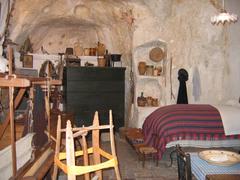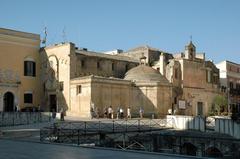Palasassi Visiting Hours, Tickets, and Historical Sites in Matera, Italy
Date: 04/07/2025
Introduction to Palasassi and Its Significance in Matera
Palasassi, located at the heart of the extraordinary Sassi districts of Matera, Italy, stands as one of the world’s oldest continuously inhabited human settlements. Matera’s labyrinth of cave dwellings—carved into the limestone cliffs—offers visitors an unparalleled journey through thousands of years of adaptation, resilience, and culture. Recognized as a UNESCO World Heritage Site since 1993, the Sassi di Matera, including Palasassi, exemplify the Mediterranean’s best-preserved troglodyte settlements (UNESCO). Once a symbol of poverty, Palasassi has been transformed into a vibrant hub for history, art, and living traditions (Italia.it; Anna Everywhere).
This guide provides a comprehensive overview of Palasassi’s historical evolution, its architectural marvels, and practical information for planning your visit. Whether you are an archaeology enthusiast, a lover of Italian culture, or a curious traveler, you will find all the essential details on visiting hours, ticketing, accessibility, and the best experiences in Matera’s iconic Sassi.
Historical Overview
Prehistoric and Ancient Origins
Palasassi is rooted in one of the world’s oldest inhabited landscapes. Archaeological finds, such as those from the Grotta dei Pipistrelli, reveal evidence of human presence from the Lower Paleolithic—about 400,000 years ago (Hotel Belvedere). By the Neolithic, the area saw fortified villages and the emergence of permanent settlements, such as Serra d’Alto and Murgia Timone (Italia.it). The first cave dwellings were carved into the soft limestone, forming a unique urban landscape that would evolve for millennia (Wikipedia: Sassi di Matera).
Classical Antiquity and Early Christian Era
During the era of Magna Graecia and later under Roman rule, Matera became an important trade and transit center. The Sassi adapted to new cultural and economic realities, while the spread of Christianity led to the creation of numerous rock-hewn churches decorated with Byzantine frescoes (Anna Everywhere). Notable examples, such as the Crypt of the Original Sin, date back to the 8th century and highlight Matera’s spiritual significance (Italia.it).
Medieval Development and Social Structure
Throughout the Middle Ages, the Sassi—Palasassi included—grew into a densely populated urban quarter. The social life revolved around the vicinato, communal courtyards that fostered strong community ties (Smithsonian Magazine). Above-ground buildings, palazzi, and chapels were interspersed among the caves, forming a complex, multi-layered urban landscape (Anna Everywhere).
Decline, Marginalization, and 20th-Century Abandonment
From the Renaissance onwards, the Sassi suffered increasing neglect and poverty. By the 20th century, overcrowding and lack of sanitation made Matera “the shame of Italy.” In the 1950s, thousands were forcibly relocated to modern housing, leaving the ancient quarters abandoned (London City Calling).
Rediscovery, Restoration, and UNESCO Recognition
In the 1970s and 1980s, local campaigns for preservation led to extensive restoration. The Sassi’s inscription as a UNESCO World Heritage Site in 1993 sparked further investment and transformation. Today, many cave dwellings are boutique hotels, galleries, and restaurants, and Palasassi is a symbol of successful cultural renewal (Wikipedia: Sassi di Matera; UNESCO).
Contemporary Significance and Cultural Renaissance
Matera’s designation as European Capital of Culture in 2019 brought global attention to Palasassi, establishing it as a center for festivals, art, and gastronomy (Adventure Backpack). Events like the Sassi Festival and the Matera Film Festival, alongside traditional celebrations such as the Festa della Bruna, showcase the district’s enduring vibrancy (explorecity.life).
Architectural and Urban Features
The architecture of Palasassi is a testament to centuries of adaptation. The district’s maze of cave dwellings, stairways, and communal courtyards is interwoven with rock-hewn churches and Renaissance palazzi. Ingenious water collection systems, such as the Palombaro Lungo cistern, highlight the resourcefulness of its inhabitants (Anna Everywhere). The result is a unique landscape where history and daily life merge seamlessly (London City Calling).
Visiting Palasassi: Practical Information
Visiting Hours
- District Access: Open year-round, 24/7.
- Key Sites (e.g., museums, churches): Typically 9:00 AM–7:00 PM, with seasonal variations. Some sites extend to 9:00 PM during summer.
- Tip: Always check official websites or local visitor centers for the latest hours.
Tickets and Entry Requirements
- General District: Free public access.
- Museums/Churches (e.g., Casa Grotta, Crypt of the Original Sin): Tickets typically €3–€10. Combo tickets available for multiple sites.
- Purchase: Online or at ticket offices; advance booking recommended in peak seasons.
How to Get There
- By Train: Direct regional trains from Bari via Ferrovie Appulo Lucane; about 1.5 hours (Never Ending Voyage).
- By Car: Note that Palasassi and the Sassi are within a Limited Traffic Zone (ZTL). Park in designated lots (e.g., Via Saragat, Via Timmari) and use shuttles (Sassi Tour; Matera Turismo).
- By Bus: Long-distance buses connect Matera with major cities; main terminal near Piazza della Visitazione.
Navigating Palasassi
- On Foot: The best way to explore; wear sturdy, non-slip footwear.
- Guided Tours: Walking tours and Ape Calessino (tuk-tuk) tours are available, including night tours to see the illuminated Sassi (Italy Unseen).
- Accessibility: The terrain is steep and uneven. Some museums and tours accommodate limited mobility, but advance inquiries are necessary (Sassi Tour).
Best Time to Visit
- Spring (April–June) and Autumn (September–October): Mild weather, fewer crowds.
- Summer: Hot and busy—visit early or late in the day.
- Winter: Quieter, but some sites may have reduced hours (Mamma Mia Indeed).
Accommodation
Consider cave hotels or B&Bs within the Sassi for a unique local experience. The modern center offers more conventional hotels and greater accessibility (Italy Unseen).
Food and Shopping
Sample local specialties like Pane di Matera, orecchiette pasta, and crispy peperoni cruschi. Look for ceramics, woven textiles, and gourmet foods in local shops (explorecity.life; Italy Unseen).
Highlights and Nearby Attractions
- Casa Noha: Multimedia history exhibits.
- Palombaro Lungo: Vast ancient cistern beneath Piazza Vittorio Veneto.
- Church of Santa Maria de Idris & San Pietro Caveoso: Notable rock-hewn churches.
- Murgia National Park: Hiking and panoramic views of the Sassi.
- Museums (e.g., MUSMA, Palazzo Lanfranchi): Contemporary and regional art.
Frequently Asked Questions (FAQ)
Q: What are Palasassi’s visiting hours?
A: The district is always open; main sites generally operate 9:00 AM–7:00 PM, with some seasonal changes.
Q: How much do tickets cost?
A: Outdoor areas are free. Museums and select churches charge €3–€10; combo tickets are available.
Q: Is Palasassi accessible for people with disabilities?
A: Accessibility is limited due to historic terrain; inquire in advance for specific accommodations.
Q: What’s the best time to visit?
A: Spring and autumn offer ideal weather and fewer tourists.
Q: Are guided tours available?
A: Yes, walking and tuk-tuk tours are widely available, including thematic and night tours.
Essential Visitor Tips
- Footwear: Wear non-slip, comfortable shoes.
- Water: Carry a bottle, especially in summer.
- Maps: Download offline maps or use local signage.
- Photography: Allowed outdoors; check restrictions inside churches.
- Respect: Be mindful of residents and private homes.
Visual Media
Enhance your planning and experience with high-quality images of Palasassi’s cave dwellings, rock-hewn churches, and panoramic Sassi views. Use SEO-friendly alt text such as “Palasassi cave dwellings in Matera” and “Sassi di Matera UNESCO World Heritage Site.”
Internal Links
External Links
- Official Matera Tourism
- UNESCO World Heritage Site: Sassi di Matera
- Visit Italy - Matera Guide
- sassidimatera.net
- Never Ending Voyage
- Sassi Tour
- Italy Unseen
- Matera Turismo
Summary
Palasassi is a living testament to human ingenuity, cultural continuity, and successful revitalization. From ancient cave dwellings to vibrant festivals and thriving artisan workshops, the district offers visitors a deep and rewarding experience. Careful planning—regarding visiting hours, tickets, and accessibility—will ensure a memorable journey through time in one of Italy’s most treasured sites. For up-to-date information, download the Audiala app, consult official tourism websites, and follow our channels for real-time tips and event updates.
Sources and Further Reading
- Hotel Belvedere
- Italia.it
- Wikipedia: Sassi di Matera
- Smithsonian Magazine
- London City Calling
- UNESCO
- explorecity.life
- Continuous Roamer
- TravelToItalyGuide
- TouristSecrets
- Never Ending Voyage
- Italy Unseen
- Adventure Backpack
- Matera Turismo
- sassidimatera.net


